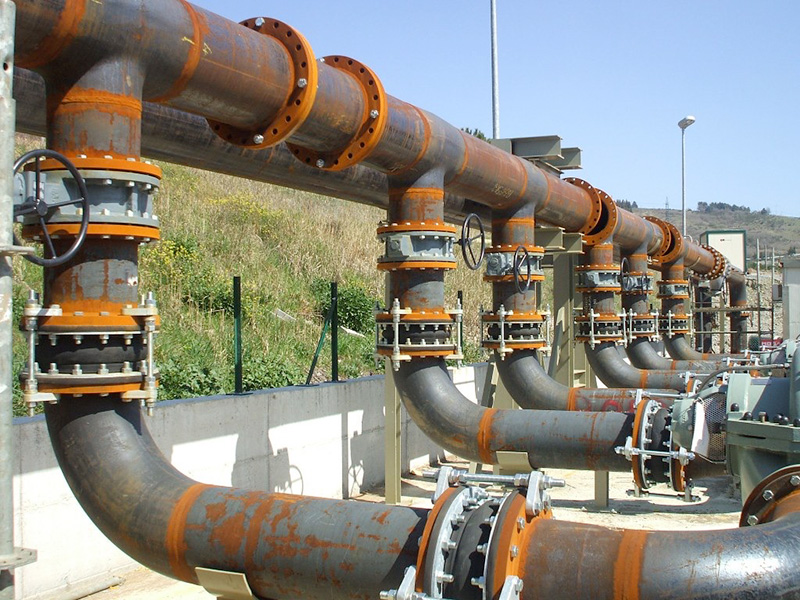
PERFORMANCE AND CONSTRUCTION FEATURES
- Test pressure upto 24 bar (upto 300NB)
- Cyclic movement test for 5000 cycles under design pressure conducted on sizes 1600NB, 2100NB and 2200NB bellows.
- Manufactured sizes upto 3600mm (144 inches).
- Safety factor built in upto 4:1.
- Low spring rates.
- Greater movement per arch.
- Manufactured in single or multiple arches.
- Choice of eight liner elastomers
- Choice of cover to match liner materials or different materials for better resistance to external conditions.
- Filled or unfilled arches.
- Galvanised carbon steel or stainless steel split backup rings.
- Can be built with permanent offset to compensate for existing or designed piping misalignment.
- Rubber expansion joints are a type of industrial joint that are designed to compensate for the movement caused by thermal expansion and contraction, vibrations, and misalignment in piping systems. These joints are made from high-quality rubber material and are designed to provide superior flexibility and durability, making them an excellent choice for a wide range of industrial applications.
Features
- Rubber expansion joints have several features that make them an excellent choice for industrial applications. They are highly flexible and can absorb vibrations, making them ideal for use in piping systems that are exposed to high levels of vibration. They are also highly durable and resistant to corrosion, making them suitable for use in harsh environments. Rubber expansion joints can also withstand high temperatures and pressure fluctuations, ensuring the longevity of the joint and preventing equipment failure.
Applications
- Rubber expansion joints are widely used in various industrial applications, including chemical processing, power generation, wastewater treatment, and HVAC systems. They are commonly used to compensate for thermal expansion and contraction in piping systems, absorb vibrations, and reduce noise levels. They are also used to connect pipes of different sizes and types, and to compensate for misalignment and offset.
Advantages
- The use of rubber expansion joints can bring several advantages to industrial processes. They can significantly reduce maintenance costs by protecting equipment from wear and tear, thereby extending its lifespan. Rubber expansion joints are highly flexible, allowing them to absorb vibrations and prevent damage to the piping system. They can also enhance workplace safety by reducing the risk of accidents caused by equipment failure or malfunctions. Additionally, rubber expansion joints are easy to install and maintain, making them a cost-effective solution for a variety of industrial processes.
Conclusion
- Rubber expansion joints are an excellent choice for industrial applications that require flexibility, durability, and resistance to corrosion, high temperatures, and pressure fluctuations. With their unique features and wide range of applications, these joints can provide long-lasting protection to equipment, reduce maintenance costs, enhance productivity, and improve workplace safety.
FAQs of Rubber Expansion joints
Q: What are rubber expansion joints?
A: Rubber expansion joints are flexible connectors made of rubber and other materials that absorb movements and stresses in piping systems caused by thermal expansion and contraction, vibration, and misalignment.
Q: What are the advantages of using rubber expansion joints?
A: Rubber expansion joints offer many benefits, such as reducing noise and vibration, preventing damage to piping systems, reducing maintenance costs, and increasing the lifespan of piping systems.
Q: What types of rubber expansion joints are available?
A: There are several types of rubber expansion joints, including single sphere, double sphere, sleeve, and arch. Each type has its own unique characteristics and applications.
Q: What factors should be considered when selecting a rubber expansion joint?
A: Several factors should be considered when selecting a rubber expansion joint, including the type of fluid being transported, the temperature and pressure of the system, the size and length of the pipe, and the amount of movement and misalignment the system experiences.
Q: How do you install a rubber expansion joint?
A: The installation process for rubber expansion joints will depend on the specific type of joint being used and the application. In general, the joint should be securely fastened to the piping system, and proper support and anchoring should be provided to prevent excessive movement.
Q: How do you maintain rubber expansion joints?
A: Regular inspection and maintenance are necessary to ensure that rubber expansion joints continue to function properly. This includes checking for signs of wear and tear, such as cracks, bulges, or leaks, and replacing the joint as needed.

